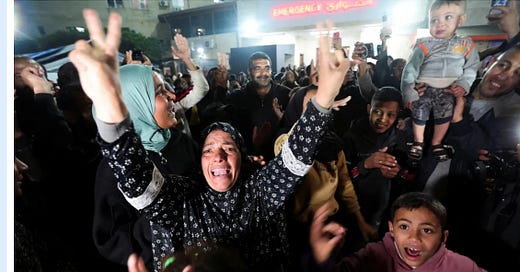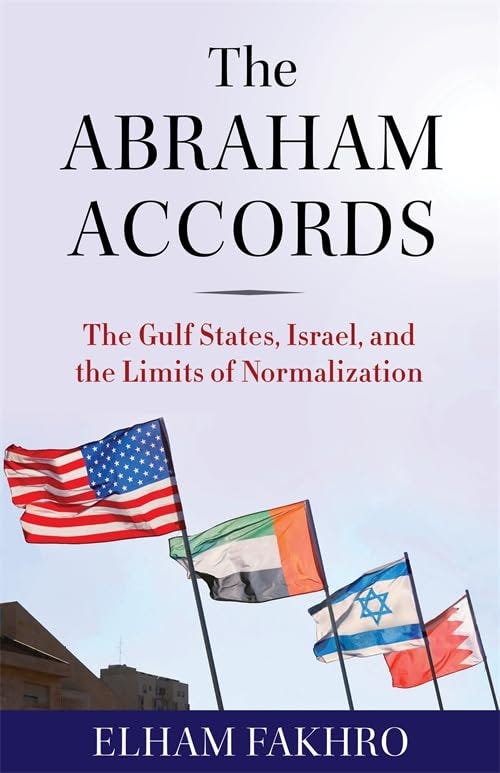What to expect from the Gaza ceasefire
Plus, a new podcast about the Abraham Accords and the latest from the MENA Academy
After some last minute jockeying, it looks like the Israel-Hamas ceasefire is set to go into effect on January 19. Yesterday, Foreign Affairs asked me to talk through some of the issues involved and what to expect once the ceasefire goes into effect. They have just published an edited version of the conversation, which I’m delighted to share paywall free.
I’m extremely glad to see any end, even if it’s only a pause, to Israel’s killing and devastation of Gaza and its people. It should have happened a long time and many thousands of deaths ago, and it’s an indictment of Biden and his team’s refusal to apply any serious leverage over Israel that it took so long to reach essentially the same deal that was laid out eight months ago. But, like most people, I find it hard to be optimistic about the long-term prospects for the ceasefire holding, much less evolving into a broader peace. There’s so many potential spoilers on both sides, strong incentives for Israeli leaders in particular to not have the war end, and so many reasons that could be found to rekindle the killing.
In the short conversation I try to go beyond the obvious to offer some suggestions on what we should look at as indicators of which way things could go. I think that the key early indicator, beyond whether violence actually ends, will be whether and how Israel allows the promised influx of humanitarian aid. The virtually unfathomable devastation on the ground in Gaza which makes bare survival difficult, much less reconstruction; will the ceasefire allow meaningful access?
I would keep an eye on the humanitarian assistance to get a sense of how things will play out. If you get a real surge of aid, not just food and medicine but also materials to rebuild shattered infrastructure, that could do an enormous amount of good to relieve the suffering of Palestinian civilians and put the cease-fire on a solid path. But throughout this conflict, Israel has agreed, under American pressure, to increase humanitarian assistance. And for the most part, it just doesn’t happen. So it’s entirely possible that you end up with an end to direct violence, but a surge of aid on paper that doesn’t actually mean very much for the people on the ground.
It’s also easy to see the profound absence of any serious plan for governance in Gaza, presumably without a formal Hamas role, beyond trying to resuscitate the debilitated, unpopular and illegitimate Palestinian Authority with Gulf cash to play the role of Israeli proxy police force in Gaza like it does in the West Bank. And even that is contentious with those Israelis who would rather see the PA collapsed or sidelined to clear the way for faster annexation and settlement. The ongoing talks about Phases Two and Three are pretty notional; even if Phase One manages to take hold, it’s hard to imagine ever getting to Phase Two given the fundamentally incompatible visions of the two sides for what the future of Gaza might look like.
Our short conversation ranges over Israeli domestic politics, the risks of escalation to a broader war, the future of Hamas, how an end to the killing in Gaza might open up space for a return yet again to hunting the Saudi-Israeli normalization white whale, the ever-deeper entrenchment of the One State Reality, and the big questions about Trump’s intentions. FA asked whether the ceasefire might improve America’s image with Arabs:
Across the Arab world, the general sense is that the United States aided, abetted, and armed a genocide against the Palestinian people. A cease-fire that takes place after so many are dead and so much has been destroyed isn’t going to make them feel better about America. It is way too little, way too late.
Please do check out the whole conversation over at Foreign Affairs (no paywall). I hope the killing stops and reconstruction begins in a sustained way, but it’s going to take a lot more than we’ve seen to date to make that happen.
And now, for this week’s dispatch from the MENA Academy, featuring a podcast conversation with Elham Fakhro about her new book on the Abraham Accords and several related academic articles.
On this week’s Middle East Political Science Podcast, I talked with Elham Fakhro, formerly of the Crisis Group and now at Harvard’s Kennedy School, about her new Columbia University Press book The Abraham Accords. It’s the first academic book length study of the Accords of which I’m aware, based on hundreds of interviews on all sides of the process. Fakhro explores the origins, negotiation, and impact of the Abraham Accords across multiple dimensions, showing both the strategic logic for the parties involved and the significant costs for both domestic publics (the unpopular agreements demand greater autocratic repression) and for the Palestinian issue (utterly ignored). She makes some really interesting points about the strategic convergences underlying the move towards a deal, especially for the UAE, and offers some fascinating observations about how popular opposition has manifested in Gulf countries since Gaza — notably the broad support for the boycott campaign.
You can listen to our conversation here:
On a related note, it’s worth checking out this data analysis piece from the Arab Barometer on Arab support for normalization with Israel— which, unsurprisingly, has largely collapsed (from already low levels) since Gaza. In no country surveyed does support for normalization now exceed 13%.
You should also check out this framing essay for the Mediterranean Politics symposium on Arab Islamists and Gaza, by Jeroen Gunning and Morten Valbjørn: “A year after Hamas’s 7 October 2023 attacks and Israel’s war on Gaza, it is clear that Islamists across the region are significant actors in the conflict and that the Arab Islamist field has been affected by the war. This raises several questions. How have Islamists responded to the war on Gaza? To what extent has the conflict triggered new dynamics? How can we explain spatial and temporal variations, and what might this say about (the study of) Islamism – and social movements more broadly? While support for Palestine is broad, not all Islamists responded alike and that, although the war has triggered notable changes, there are important continuities. We note that ideology is a poor predictor of behaviour, with significant variations within sub-categories and across national contexts, as ideology and interests intersect within political opportunity and threat structures. Transnational dynamics are refracted through domestic conditions and, though Iran is the enabler, relations between members of the Axis of Resistance are also important.”
You won’t want to miss “Israel, Annexation, and Sovereignty: Within the Green Line and Across It,” from Ian Lustick and M.T. Samuel, forthcoming in the International Journal of Middle Eastern Studies. Here’s the abstract: “From the early years of Israel’s occupation of the West Bank and Gaza Strip, observers predicted that their de facto annexation might occur. Fifty-seven years later, it has happened. Although governed differently than other zones within the Israeli state, neither territory can be separated from Israel. Yet, the territories’ official status is that they are not part of the state. We offer four reinforcing analyses—legal, historical, discursive, and political—of this sustained discrepancy between what is and what is officially said to be. By analyzing Israel’s juridical techniques for regularizing the incorporation of territories occupied beginning in 1948, we show that de facto annexation has been Israel’s predominant form of territorial expansion. This helps account for the failure to implement de jure annexation, the intensity of conflict over attempts to overhaul the Israeli judiciary, and debates over the future of postwar Gaza.”






